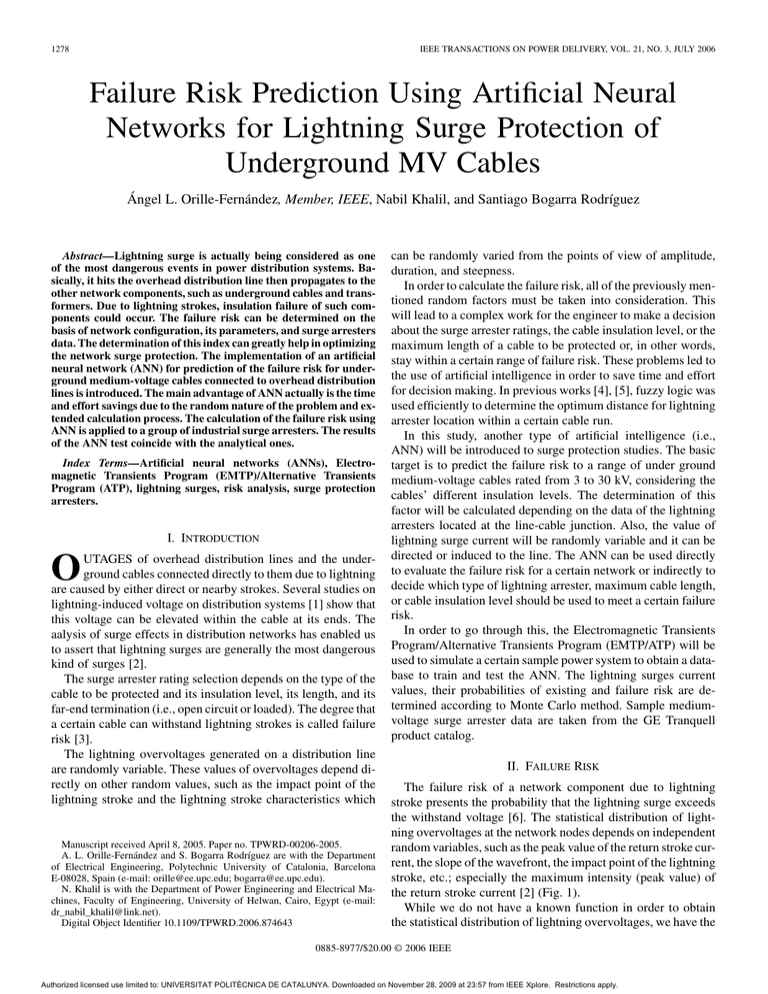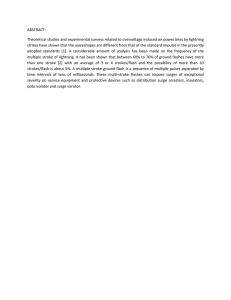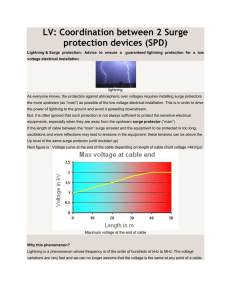Downloaded
advertisement

1278 IEEE TRANSACTIONS ON POWER DELIVERY, VOL. 21, NO. 3, JULY 2006 Failure Risk Prediction Using Artificial Neural Networks for Lightning Surge Protection of Underground MV Cables Ángel L. Orille-Fernández, Member, IEEE, Nabil Khalil, and Santiago Bogarra Rodríguez Abstract—Lightning surge is actually being considered as one of the most dangerous events in power distribution systems. Basically, it hits the overhead distribution line then propagates to the other network components, such as underground cables and transformers. Due to lightning strokes, insulation failure of such components could occur. The failure risk can be determined on the basis of network configuration, its parameters, and surge arresters data. The determination of this index can greatly help in optimizing the network surge protection. The implementation of an artificial neural network (ANN) for prediction of the failure risk for underground medium-voltage cables connected to overhead distribution lines is introduced. The main advantage of ANN actually is the time and effort savings due to the random nature of the problem and extended calculation process. The calculation of the failure risk using ANN is applied to a group of industrial surge arresters. The results of the ANN test coincide with the analytical ones. Index Terms—Artificial neural networks (ANNs), Electromagnetic Transients Program (EMTP)/Alternative Transients Program (ATP), lightning surges, risk analysis, surge protection arresters. I. INTRODUCTION O UTAGES of overhead distribution lines and the underground cables connected directly to them due to lightning are caused by either direct or nearby strokes. Several studies on lightning-induced voltage on distribution systems [1] show that this voltage can be elevated within the cable at its ends. The aalysis of surge effects in distribution networks has enabled us to assert that lightning surges are generally the most dangerous kind of surges [2]. The surge arrester rating selection depends on the type of the cable to be protected and its insulation level, its length, and its far-end termination (i.e., open circuit or loaded). The degree that a certain cable can withstand lightning strokes is called failure risk [3]. The lightning overvoltages generated on a distribution line are randomly variable. These values of overvoltages depend directly on other random values, such as the impact point of the lightning stroke and the lightning stroke characteristics which Manuscript received April 8, 2005. Paper no. TPWRD-00206-2005. A. L. Orille-Fernández and S. Bogarra Rodríguez are with the Department of Electrical Engineering, Polytechnic University of Catalonia, Barcelona E-08028, Spain (e-mail: orille@ee.upc.edu; bogarra@ee.upc.edu). N. Khalil is with the Department of Power Engineering and Electrical Machines, Faculty of Engineering, University of Helwan, Cairo, Egypt (e-mail: dr_nabil_khalil@link.net). Digital Object Identifier 10.1109/TPWRD.2006.874643 can be randomly varied from the points of view of amplitude, duration, and steepness. In order to calculate the failure risk, all of the previously mentioned random factors must be taken into consideration. This will lead to a complex work for the engineer to make a decision about the surge arrester ratings, the cable insulation level, or the maximum length of a cable to be protected or, in other words, stay within a certain range of failure risk. These problems led to the use of artificial intelligence in order to save time and effort for decision making. In previous works [4], [5], fuzzy logic was used efficiently to determine the optimum distance for lightning arrester location within a certain cable run. In this study, another type of artificial intelligence (i.e., ANN) will be introduced to surge protection studies. The basic target is to predict the failure risk to a range of under ground medium-voltage cables rated from 3 to 30 kV, considering the cables’ different insulation levels. The determination of this factor will be calculated depending on the data of the lightning arresters located at the line-cable junction. Also, the value of lightning surge current will be randomly variable and it can be directed or induced to the line. The ANN can be used directly to evaluate the failure risk for a certain network or indirectly to decide which type of lightning arrester, maximum cable length, or cable insulation level should be used to meet a certain failure risk. In order to go through this, the Electromagnetic Transients Program/Alternative Transients Program (EMTP/ATP) will be used to simulate a certain sample power system to obtain a database to train and test the ANN. The lightning surges current values, their probabilities of existing and failure risk are determined according to Monte Carlo method. Sample mediumvoltage surge arrester data are taken from the GE Tranquell product catalog. II. FAILURE RISK The failure risk of a network component due to lightning stroke presents the probability that the lightning surge exceeds the withstand voltage [6]. The statistical distribution of lightning overvoltages at the network nodes depends on independent random variables, such as the peak value of the return stroke current, the slope of the wavefront, the impact point of the lightning stroke, etc.; especially the maximum intensity (peak value) of the return stroke current [2] (Fig. 1). While we do not have a known function in order to obtain the statistical distribution of lightning overvoltages, we have the 0885-8977/$20.00 © 2006 IEEE Authorized licensed use limited to: UNIVERSITAT POLITÈCNICA DE CATALUNYA. Downloaded on November 28, 2009 at 23:57 from IEEE Xplore. Restrictions apply. ORILLE et al.: FAILURE RISK PREDICTION USING ARTIFICIAL NEURAL NETWORKS 1279 Fig. 2. Failure risk of a network component. Fig. 3. Simulated sample power system. Fig. 1. Statistical distribution of the peak value of the return stroke. EMTP/ATP which allows us to generate the statistical distribution of lightning overvoltages in the network nodes. In order to determine the values of lightning overvoltages at the network nodes, we need to use a procedure offering random values of independent variables, of which the statistical distributions are known. The procedure considered most convenient is the Monte Carlo method [7]. It is assumed that lightning overvoltage distribution is the Gaussian density function % (1) where is the probability density of overvoltage occurrence, is % the overvoltage for which the probability density of occurrence is 50%, and is the standard deviation. It is assumed that the probability of disruptive discharge of insulation is given by a Gaussian cumulative probability function % (2) is the probability of disruptive discharge; where % is the voltage under which the insulation has a 50% probability to flashover or to withstand; and is the standard deviation. The failure risk of a network component (Fig. 2) is calculated by taking the distribution of applied overvoltages together with the distribution of its withstand voltages and is expressed as [3] Fig. 4. Surge arrester model. consists of a distribution line connected to an underground medium-voltage cable. A surge arrester is located at the line cable junction. The surge arrester is connected to ground via a in series with an inductance . The resistance resistance simulates the grounding wire and ground resistance, while the inductance is the grounding wire inductance. The distribution line is considered to be infinitely long. The cable is considered to be open circuited at the load end. The lightning surge is simulated using a dual exponential current source that injects current in the distribution line 15 m away from the line cable junction. The lightning arrester is simulated using the simplified model [8] of the IEEE model [9]. Fig. 4 shows the electric equivalent circuit of a surge arrester. In this model, the lightning arrester is modeled using two nonlinear resistances A0 and A1 and two inductances L0 and L1. L0 and L1 are calculated according to the following equations [8] on the base of 10-kA current surge: (4) (5) (3) where is the failure risk; overvoltage occurrence; and tive discharge. is the probability density of is the probability of disrup- III. POWER SYSTEM MODELING In order to train the ANN, a sample power system will be simulated to generate the necessary input– output training patterns. The power system sample shown in Fig. 3 will be simulated using the Electromagnetic Transients Program (EMTP)/Alternative Transients Program (ATP). The system where is the residual voltage at 10-kA fast front current s) or ( s), is the residual voltage at 10-kA curve ( s), and Vn is the arrester rated fast front current curve ( voltage. A resistance with a value of 1 M is located across the terminal of the surge arrester. The current source simulates the direct lightning surge current or the induced current in the line caused by nearby surge. The distribution line and cable characteristic impedances and propagation speeds are 350 , 300 m/ s, 50 and 150 m/ s, respectively. Authorized licensed use limited to: UNIVERSITAT POLITÈCNICA DE CATALUNYA. Downloaded on November 28, 2009 at 23:57 from IEEE Xplore. Restrictions apply. 1280 IEEE TRANSACTIONS ON POWER DELIVERY, VOL. 21, NO. 3, JULY 2006 IV. ANN DESIGN, TRAINING, AND TESTING Fig. 5. Application of the electrogeometric model. The electrogeometric model is used to predict the probability of the lightning to hit the distribution line. The induced magnetic field caused by the lightning surge depends directly on the distance between the object and the lightning surge itself. Fig. 5 explains this phenomenon [10]. The distance between an object in this study is the distribution line or the earth, and the end of the main discharge can be calculated as follows: (6) is the impact distance in meters, and is the lightning where surge current. The direct impact of the lightning surge to the distribution line will generate a current wave. This wave will split into to equal parts, each one travels in a certain direction. Otherwise, if the surge hit the ground, it will induce a certain voltage on the line which, in turn, will induce a current wave which has a value depending on the line parameters. The induction atmospheric overvoltages are generated from lightning surges impact near power lines. This overvoltage is a function of the maximum and duration of the surge current, the principal velocity of the primary discharge, the power line height, and the distance between the lightning surge impact and the power line. The induced overvoltage can be calculated according to Rusck [10] (7) where lightning surge current in kiloamperes; induced overvoltage on the line in kilovolts; height of the power line in meters; distance between the line and the power line in meters; propagation velocity of the surge in the media under study in kilometers per second; speed of light in space in kilometers/s. The ANN used in this work is a feedforward neural network that has eight inputs and five outputs. The ANN inputs are the normalized values of the following: 1) the network nominal voltage (from 3-to-30-kV line to line); 2) network maximum permissible voltage (120% of the rated voltage); 3) cable maximum impulse withstand voltage; 4) surge arrester rated voltage (from 3-to-36-kV line to ground); 5) surge arrester rated current (5, 10, 20, 40 kA); 6) surge arrester ground wire inductance (1.25 H/m and tower height from 8 to 14 m); 7) ground resistance plus grounding cable resistance one between 1 to 10 ; 8) protected cable length (from 15 to 150 m). All of these values are normalized by their maximum values. The ANN output is the risk factor to be predicted. In order increase the accuracy of the ANN output, the ANN will have five outputs. The risk factor will be codified in the following manner: If the risk factor is R and O1, O2, O3, O4, and O5 are the outputs then , the 1) if , and ; , the 2) if , and ; , the 3) if , and ; , the 4) if , and ; , the 5) if , and . The segmoidal activation function used in the different neurons of the ANN has the following formula: (8) where is the neuron activation function input; is the activation function output, and is the slope factor. Note that each neuron has a minimum output of and a because the symmetrical segmoidal function is maximum of used. An inverse for the above five cases is applied to translate the ANN output to failure risk. However, the output of the ANN or . It is found that the segmoidal is real numbers, not only , 0.33 for the functions of the first hidden layer are second hidden layer, and 0.4 for the output layer in order to decrease the output error. The ANN training patterns are generated by simulating the power system mentioned in Fig. 3, applying random values of s and a peak value from the lightning stroke current of 100 A to 400 kA with different values of surge arrester characteristic voltages according to Table I [11]. The network voltages, the corresponding rating values of the lighting arresters, and the corresponding minimum and maximum insulation levels according to the Electric Network of Spain are shown in Table II [12]. Authorized licensed use limited to: UNIVERSITAT POLITÈCNICA DE CATALUNYA. Downloaded on November 28, 2009 at 23:57 from IEEE Xplore. Restrictions apply. ORILLE et al.: FAILURE RISK PREDICTION USING ARTIFICIAL NEURAL NETWORKS 1281 TABLE I GE TRANQUELL HEAVY DUTY ARRESTERS Fig. 7. Simulation and test results for a failure risk factor between 0.4 and 0.6. TABLE II SURGE ARRESTERS-RATED VALUE, MINIMUM AND MAXIMUM IMPULSE WITHSTAND VOLTAGES AS A FUNCTION OF RATED NETWORK VOLTAGE Fig. 8. Simulation and test results for a failure risk factor between 0.4 and 0.5. Fig. 6. Simulation and test results for a failure risk factor greater than 0.6. The designed ANN has eight inputs, ten neurons in each if the two hidden layers, and five output neurons. The testing of the ANN is performed with other groups of data differing from the training ones. The test results can be summarized as follows. 1) Fig. 6 shows the value of the risk of the failure index calculated from simulation results and ANN outputs in cases where the risk of failure is greater than 0.6. These cases correspond to a network voltage of 3 kV and lightning arrester of 6 kV with 20 and 40 kA. 2) Fig. 7 shows the same comparison where the failure risk is between 0.4 and 0.6. This situation corresponds to cable voltage that is equal to or more than 6 kV and extreme conditions of cable length of more than 130 m, surge arrester maximum voltage rating, and highest current capacity. Fig. 9. Simulation and test results for a failure risk factor between 0.2 and 0.4. 3) Fig. 8 shows the simulation result and ANN output in cases where the failure risk is between 0.4 and 0.5. This is for cables of 10 kV and over, and a maximum cable length of 75 m with a surge arrester capacity of 5 kA to 20 kA. 4) Fig. 9 shows the simulation results and ANN outputs in cases where the failure risk is between 0.2 and 0.4. This is for cables of 15 kV and over with a maximum cables’ impulse withstand voltage. The ANN mentioned before can be used to decide the optimal surge arrester ratings, the cable’s length, or its insulation level to meet a certain failure risk. This can be done by changing the input values and observe the failure risk. Authorized licensed use limited to: UNIVERSITAT POLITÈCNICA DE CATALUNYA. Downloaded on November 28, 2009 at 23:57 from IEEE Xplore. Restrictions apply. 1282 IEEE TRANSACTIONS ON POWER DELIVERY, VOL. 21, NO. 3, JULY 2006 V. CONCLUSION To help in surge protection and power system reliability studies and to save time for the calculation of the failure risk of medium-voltage underground cables, ANNs were introduced. The obtained values of the ANN in this field encourage its use for prediction of failure risk and other surge protection-related subjects. The special design of the ANN output and the selection of the segmoidal function parameters enhanced its analogue output values and reduced its error. Moreover, the ANN succeeded in covering most of the possible cases along with the usage of real parameter of existing surge arresters. The developed ANN training patterns used the statistical random values of lightning parameters. The statistical distribution of these parameters values were generated using the Monte Carlo method. The statistical distribution of lightning overvoltages is obtained from surges calculated by EMTP/ATP. REFERENCES [1] S. Bogarra, “Overvoltage Restriction in Power Systems,” Ph.D. dissertation, Dept. Elect. Eng., Polytechnic Univ. Catalonia, Barcelona, Spain, 2001. [2] B. De Metz-Noblat, Lightning and HV electrical installations, in Schneider Electric, no. 168, 1998. Tech. Library. [3] IEEE Guide for the Application of Metal Oxide Surge Arrester for Alternating-Current Systems, 1991. IEEE C62.22. [4] A. L. Orille, S. Bogarra, M. A. Grau, and J. Iglesias, “Fuzzy logic techniques to limit lightning surges in a power transformer,” in Proc. IEEE Power Tech Conf., vol. 2, Bologna, Italy, Jun. 23–26, 2003. [5] A. L. Orille, S. Bogarra, M. A. Grau, and J. Iglesias, “Lightning protection of power systems using fuzzy logic techniques,” in Proc. 12th IEEE Int. Conf. Fuzzy Systems, May 25–28, 2003, pp. 1406–1411. [6] Insulation Coordination. Part II: Application Guide, 1992. IEC 71.2. [7] G. J. Anders, Probability Concepts in Electric Power Systems. New York: Wiley, 1990. [8] P. Piniceti and M. Giannettoni, “A simplified model for zinc oxide surge arrester,” IEEE Trans. Power Del., vol. 14, no. 2, pp. 393–396, Apr. 1999. [9] IEEE Working Group Surge Protective Devices Committee , “Modeling of metal oxide surge arresters,” IEEE Trans. Power Del., vol. 7, no. 1, pp. 301–309, Jan. 1992. [10] P. Chowdhuri, Electromagnetic Transients in Power Systems. Somerset, U.K.: Research Studies, 1996. [11] GE Tranquell Surge Arresters, Product and Application Guide, 2000. [12] Overhead High Voltage Lines Standard, Dec. 1968. B.O.E. 27 of. Ángel L. Orille-Fernández (M’95) was born in Ujo, Spain, on June 21, 1946. He received the Ph.D. degree in electrical engineering from the Polytechnic University of Catalonia, Barcelona, Spain, in 1988. Currently, he is Professor of Electrical Engineering with the Polytechnic University of Catalonia, where he has been since 1989. He was Head of the Department of Electrical Engineering from 1995 to 2000. Nabil Khalil was born in Cairo, Egypt, on October 9, 1965. He received the B.Sc. and M.Sc. degrees in power engineering and electrical machines from the University of Helwan, Cairo, Egypt, and the Ph.D. degree in electrical engineering from the Polytechnic University of Catalonia, Barcelona, Spain, in 1999. Currently, he is with the Power Engineering and Electrical Machines Department, University of Helwan. His interests are artificial intelligence, power system studies, and power system protection. Santiago Bogarra Rodríguez was born in Gavá, Spain, on May 8, 1966. He received the Ph.D. degree in electrical engineering from the Polytechnic University of Catalonia, Barcelona, Spain, in 2002. Currently, he is Associate Professor of Electrical Engineering with the Polytechnic University of Catalonia. Authorized licensed use limited to: UNIVERSITAT POLITÈCNICA DE CATALUNYA. Downloaded on November 28, 2009 at 23:57 from IEEE Xplore. Restrictions apply.







